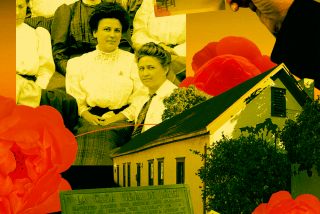SAN JUAN CAPISTRANO : Mission: to Make Past Come Alive
- Share via
The greatest challenge for a docent of Mission San Juan Capistrano isn’t absorbing the hundreds of facts and anecdotes about the mission, and it isn’t speaking before groups of tourists, the tour guides say.
Rather, the most daunting task is trying to transform a dusty collection of adobe bricks into a place of romance and living history for the thousands of schoolchildren who visit the mission every year, according to docent Bob Dunn.
“These days kids are full of Nintendo and Michael Jackson; they don’t realize that their heritage is so close to them--only about 200 years away in California,” Dunn said.
“But when we get through with them, their eyes are shining. I enjoy the challenge.”
On Saturday, the historic mission will begin its semiannual training class for volunteers who want to become docents.
Prospective guides are drilled on the rich history of the mission and the surrounding area for about 12 hours over four weeks, then are set loose to conduct tours under the guidance of an experienced docent.
What counts for the mission’s 80 docents is not only being able to recite the facts but also to make them interesting.
“We call that ‘Spanish hospitality,’ said Gordon McDonald, president of the mission Docent Society. “You have to keep their attention. You want to make people feel what it was like to live at the mission.”
Most docents are induced to volunteer by the beauty and history of the mission. But some are more immersed in the mission’s past than others.
About a dozen docents participate in the mission’s living history program and take on the persona of a figure from the past.
The last Saturday of each month during living history day, Dunn puts on a white wig, dons a custom-made outfit that a 19th-Century Spanish gentleman would wear and takes on the role of Gaspar de Portola, the first Spanish governor of California.
“I think it’s helped me as a docent,” says Dunn, who has been a docent at the mission for six years. “When you do that much research on an individual, the mission’s history becomes more immediate. You can come up with detail that you can quite often intrigue people with, interest them more in the mission.”
About 100,000 people sign up for guided tours of the mission each year. The extra cost is nominal--about $1 above the normal entrance price of $3 for adults.
Groups of no fewer than 10 people are accepted, and reservations must be made in advance.
Those taking the tour say they learn much more about the mission than they would wandering around by themselves.
“I’ve been to a lot of missions, generally on my own and with a tour,” said Tom Keefer of Burlingame.
“I am learning quite a bit today. It’s a lot easier to listen to somebody than to walk around reading plaques.”
More to Read
Sign up for Essential California
The most important California stories and recommendations in your inbox every morning.
You may occasionally receive promotional content from the Los Angeles Times.













